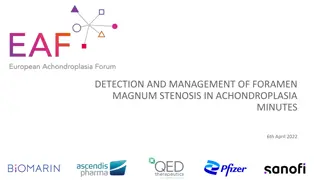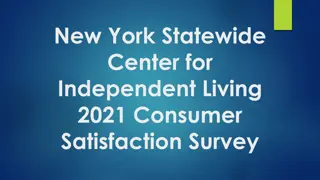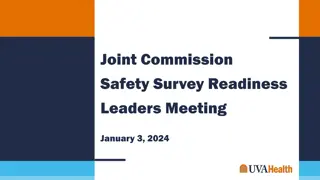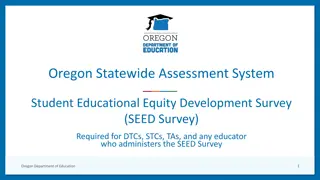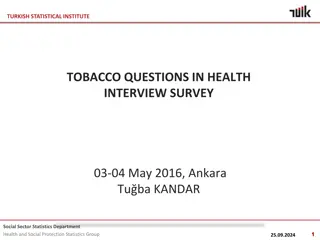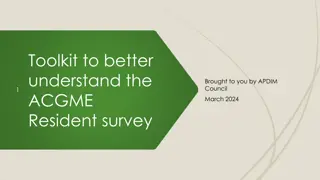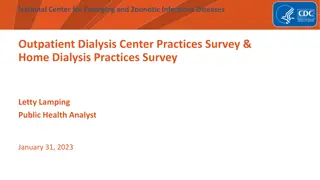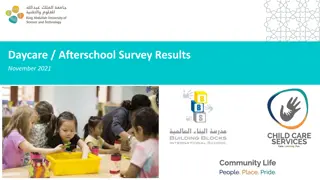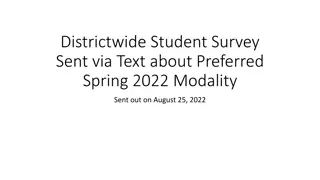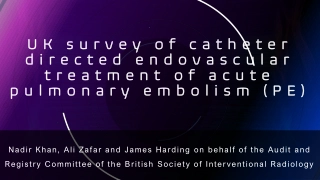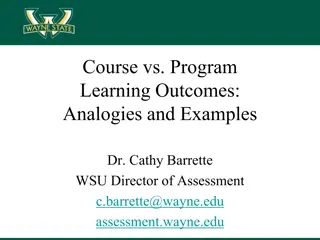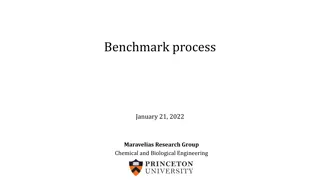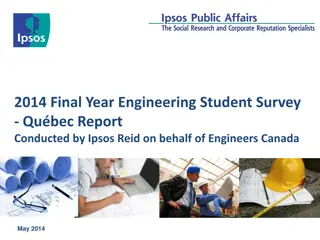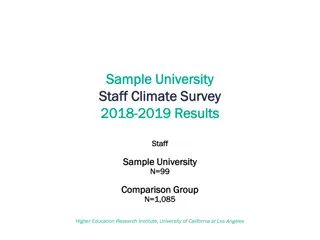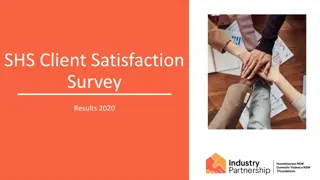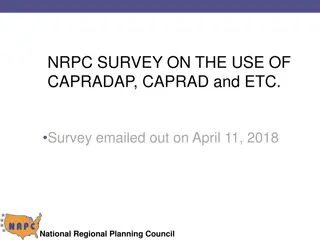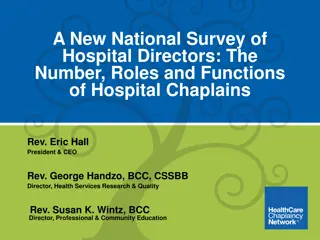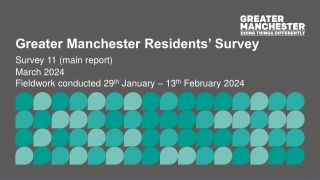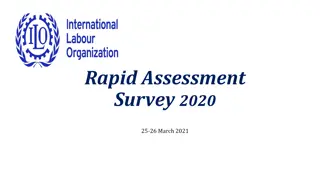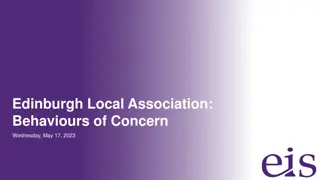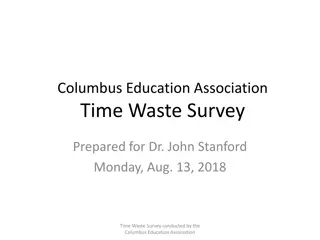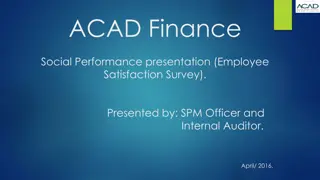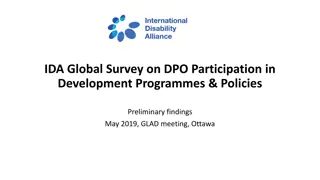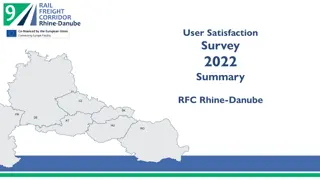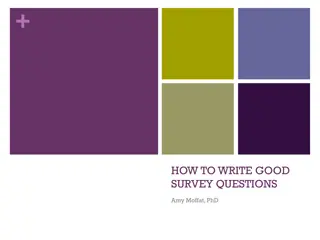Insights into Achondroplasia Treatment Outcomes Survey
Survey results from 50 respondents hailing from various countries and specialties provide valuable information on assessing outcomes in a new era of Achondroplasia treatment. Data includes respondent locations, specializations, and registry data collection. Additionally, the outcomes monitored in routine follow-up of children with Achondroplasia are detailed.
- Achondroplasia Treatment
- Survey Results
- Registry Data
- Pediatric Endocrinologists
- Orthopaedic Surgeons
Download Presentation

Please find below an Image/Link to download the presentation.
The content on the website is provided AS IS for your information and personal use only. It may not be sold, licensed, or shared on other websites without obtaining consent from the author. Download presentation by click this link. If you encounter any issues during the download, it is possible that the publisher has removed the file from their server.
E N D
Presentation Transcript
ASSESSING OUTCOMES IN A NEW ERA OF ACHONDROPLASIA TREATMENT Survey Results
GENERAL INFORMATION 50 Responses
50 respondents from a range of specialties and countries Respondent location Responses Respondent specialities* Italy 27 14 UK 7 12 Number of responses Spain 3 10 France 2 8 Portugal 2 6 Argentina 1 4 Belgium 1 2 Brazil 1 0 Ireland 1 Japan 1 Kuwait 1 Norway 1 Qatar 1 Specialty USA 1 *Respondents were able to select multiple specialties 50/50 responses
What best describes your centre or site of work? Other included: MDT group in skeletal dysplasia 2 paediatric endocrinologists; Italy Paediatric hospital Orthopaedic surgeon; Italy Respondent centres or sites of work National reference centre Academic institution/ University hospital Advocate Advocate; UK Foundation Physiotherapist; Spain Non-government organisation Advocate; Spain Patient association Psychologist; Italy General hospital Other 0 5 10 15 20 25 30 35 Number of responses 4 50/50 responses
ASSESSING OUTCOMES IN ACHONDROPLASIA 39 Responses
Are you collecting any data in a registry? Selected Yes: National database Registry for Rare Bone Disorders, Norway Hospital register Internal registry Local registry Non-government organisation Various Are respondents collecting data in a registry? Yes No 0 5 10 15 20 25 30 35 Number of responses 6 37/39 responses
What outcomes do you monitor as part of routine follow-up of children with achondroplasia? Physical measures Other included: Blood pressure BMD by DXA after the age of 5 years Body composition Expectations and quality of life Metabolic data Neurological data Orthopaedic data Thorax and waist circumference Tibial and humerus lengths Physical measures monitored in routine follow-up 100 80 % of responses 60 40 20 0 Outcome measure BMD, bone mineral density; DXA, dual-energy x-ray absorptiometry Respondents were able to select multiple answers, 39/39 responses 7
What outcomes do you monitor as part of routine follow-up of children with achondroplasia? Medical history Other included: All sleep disordered breathing symptoms Blood pressure Dentition Developmental staging Family activities Mobility issues Motor development Nutritional aspects Orthopaedic and musculoskeletal problems Relationship between parents and children Medical history measures monitored in routine follow-up 100 80 % of respondents 60 40 20 0 Neurological symptoms Pain Apnoea Hearing loss Fatigue Other Outcome measure Respondents were able to select multiple answers 39/39 responses 8
What outcomes do you monitor as part of routine follow-up of children with achondroplasia? Quality of life Other included: Hobbies/extracurricular activities Sleep quantity and quality Quality of life measures monitored in follow-up 100 80 % of responses 60 40 20 0 Independence skills Functionality Psychosocial Academic achievements Other Outcome measures Respondents were able to select multiple answers 39/39 responses 9
Do the measures listed in the previous questions accurately capture the outcomes of children with achondroplasia? Comments: Balance and coordination Daily problems with right and appearance Developmental staging Frequency of ear and throat infections Joint balance Muscular tone Neurodevelopment and spinal aspects Routine application once a year STEMS questionnaire Do the previously mentioned measures capture outcomes? Yes No 0 5 10 15 20 25 30 35 Number of responses STEMS, screening tool for everyday mobility and sympttoms 39/39 responses 10
Are there other parameters that should be measured as part of the routine follow-up of children with achondroplasia? Selected Yes: Achondroplasia specific quality of life Balance and coordination Craniofacial development Developmental milestones ENT examination Frequency of ear and throat infections IQ Joint balance List 7, especially functionality and independence skills Long-term complications Muscular tone Neuroimaging findings Orthodontic and orthognathic surgery Pubertal stage Sleep studies Spinal stenosis Are there other parameters to be measured? Yes No 0 5 10 15 20 25 30 35 Number of responses Respondents who answered yes proceeded to the next question, respondents who answered no proceeded to the next section 39/39 responses 11
Do outcome measures exist to capture the parameters identified in the previous question? Selected Yes: All objective sleep parameters Bayley scale Imaging spine Ireland et al. Pedi-CAT PROs: CHAQ (adapted for achondroplasia) QoLISSY-Brief, APLES STEMS Do the outcome measures capture previously mentioned parameters? Yes No 0 2 4 6 Number of responses 8 10 12 14 APLES, achondroplasia personal life experience scale; CHAQ, childhood health assessment questionnaire; Pedi-CAT, paediatric evaluation of disability inventory computer adaptive test; PRO, patient reported outcome; QoLISSY-Brief, quality of life in short stature youth-brief version; STEMS, screening tool for everyday mobility and symptoms. 13/15 responses from 15 respondents who answered Yes to the previous question 12
ASSESSING OUTCOMES OF CHILDREN RECEIVING VOSORITIDE 37 Responses
Do you manage children who are currently receiving vosoritide in clinical practice (NOT as part of a trial)? Do you manage children receiving vosoritide? Yes No 0 2 4 6 8 10 12 14 16 18 20 22 24 26 28 30 32 34 36 Number of responses Respondents who answered yes moved to the next question, respondents who answered no moved to the final question of the survey 37/37 responses 14
How many children are you following who are receiving vosoritide in clinical practice (NOT as part of a trial)? How many children receiving vosoritide are you following? 10 8 Numberof responses 6 4 2 0 1 5 6 10 11 20 21 30 31 40 41 50 51+ Number of patients receiving vosoritide 15 27/29 responses from 29 respondents who answered Yes to the previous question
What outcomes do you monitor as part of routine follow-up of children who are receiving vosoritide (NOT as part of a trial)? Physical measures Other included: Blood pressure BMD by DXA after the age of 5 years Body composition Hand size Thorax and waist circumference Tibial and humerus lengths Sleep studies Physical measures monitored in follow-up of children receiving vosoritide 100 80 % of responses 60 40 20 0 Outcome measure BMD, bone mineral density; DXA, dual-energy x-ray absorptiometry Respondents were able to select multiple answers, 27/29 responses 16
What outcomes do you monitor as part of routine follow-up of children who are receiving vosoritide (NOT as part of a trial)? Medical history Other included: Adverse effects Blood pressure Orthopaedic and musculoskeletal problems Nutritional aspects Sleep studies Medical history measures monitored in follow-up of children receiving vosoritide 100 80 % of responses 60 40 20 0 Neurological symptoms Pain Apnoea Fatigue Hearing loss Other Outcome measure Respondents were able to select multiple answers 27/29 responses 17
What outcomes do you monitor as part of routine follow-up of children who are receiving vosoritide (NOT as part of a trial)? Quality of life Other included: Not systematically measuring Quality of life Quality of sleep Quality of life measures monitored in follow-up of children receiving vosoritide 100 80 % of responses 60 40 20 0 Independence skills Functionality Psychosocial Academic achievements Other Outcome measure Respondents were able to select multiple answers 27/29 responses 18
Do the measures listed in the previous questions accurately capture the outcomes of children receiving vosoritide in clinical practice? Comments: Adverse events such as the local reaction of injection should be included Canal stenosis Hand size Only the respiratory part Routine application once a year Spinal deformity Tibial height Do the previously mentioned measures capture outcomes? Yes No 0 2 4 6 8 10 12 Number of responses 14 16 18 20 22 24 26 28 19 27/29 responses
Are there other parameters that should be measured as part of the follow-up of children receiving vosoritide in clinical practice? Selected Yes: Adverse events such as the local reaction of injection should be included All other organs Craniofacial development List 7, especially functionality and independence skills Long-term complications Orthodontic and orthognathic surgery Pubertal development Side effect Spinal stenosis Tolerability Are there other parameters to be measured? Yes No 0 2 4 6 8 10 12 Number of responses 14 16 18 20 22 24 26 28 Respondents who answered yes moved to the next question, respondents who answered no moved to the final question of the survey 27/29 responses 20
Do outcome measures exist to capture the parameters you identified in the previous question? Selected Yes: List 7, especially functionality and independence skills Long-term complications Objective parameters on the multi-organ involvement in achondroplasia Spinal stenosis Yes partially, some are lacking (foramen magnum score and others) Do the outcome measures capture previously mentioned parameters? Yes No 0 1 2 3 4 5 6 7 Number of responses Respondents who answered yes moved to the next question, respondents who answered no moved to the final question of the survey 7/7 responses from respondents who answered Yes to the previous question 21
Please add any other comments on assessing outcomes in children with achondroplasia Assessing outcomes in children with achondroplasia requires a multidisciplinary approach that considers various aspects of their health, development, and well-being. Regular monitoring, early intervention, and tailored support services are essential for optimizing outcomes and enhancing the quality of life for children with achondroplasia and their families Access to university graduation (paediatrician; Portugal) (neurologist; Italy) Body composition and body fat percentage should be monitored (paediatric endocrinologist and paediatrician; Italy) Expectations of parents, and for the long-term future - what [ ] is the goal of monitoring outcome; how can we as HCPs get them to adulthood well and in control of their own health outcomes (medical or clinical geneticist; UK) Dental and joint measures as well as spine assessments are needed (paediatric endocrinologist; Ireland) Families and patients have huge expectations regarding vosoritide treatment. For this reason, there is less stress about limb lengthening (orthopaedic surgeon; Italy) Given the increasing use of foramen magnum decompression in clinically asymptomatic (but MRI positive) patients, some parameter to judge the efficacy of surgery is required (neurosurgeon; UK) Foramen magnum stenosis is monitored by routine brain MRI screening in patients aged 0 to 5 in hospital (paediatric endocrinologist; Japan) 22 17/37 responses
Please add any other comments on assessing outcomes in children with achondroplasia Muscular tone, joint balance, balance and coordination (physiotherapist; Spain) Main hurdles not only lack of validated measures, and data, but also lack of time in clinic to implement (medical or clinical geneticist; Portugal) I hope vosoritide will help (paediatric endocrinologist; Kuwait) Needs to improve assessment of functionality; needs to be careful about how to assess the upper limbs functional aspects for autonomy; look at instruments/scores/scales that could help the evaluation (paediatric endocrinologist; Italy) Side effects and acceptability have to be included (medical or clinical geneticist; France) Not approved for reimbursement in our country yet (family doctor/general practitioner; Norway) We need more information about long term evolution in patient under vosoritide treatment (paediatrician; Argentina) They need support by the associations and special programs for school and physical activity (paediatric endocrinologist; Italy) We administer the PedsQL at each clinical follow-up appointment (paediatrician; Italy) PedsQL, paediatric quality of life 17/37 responses 23



